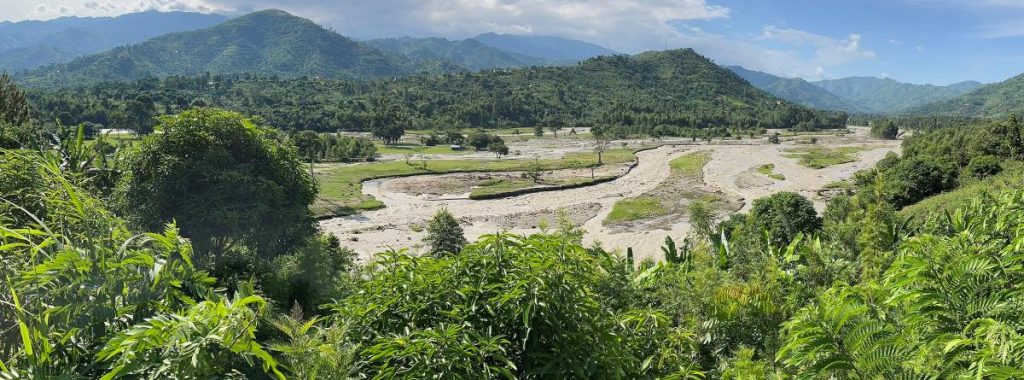
The Nyamugasani River flows through the flood plains in the foothills of Rwenzori Mountains National Park, one of the sites supported by the CAPA initiative. Image courtesy of Alec Crawford/IISD.
Protected areas such as national parks, nature reserves and Indigenous lands are the foundation of biodiversity conservation. However, climate change is threatening their effectiveness in safeguarding wildlife, ecosystem services and livelihoods.
As many countries work to meet the global target of protecting 30% of the planet’s lands and waters by 2030 — known as the 30×30 goal, a cornerstone of the Kunming-Montreal Global Biodiversity Framework — scientists are calling for the incorporation of “climate-smart” approaches into the planning of new and existing protected areas.
Key Points:
- Climate change is threatening the effectiveness of protected areas (PAs) in safeguarding wildlife, ecosystem services and livelihoods, with scientists now calling for the incorporation of “climate-smart” approaches into the planning of new and existing PAs.
- Key approaches to developing a network of climate-smart PAs include protecting climate refugia, building connectivity, identifying species’ future habitats and areas that promote natural adaptation.
- Experts emphasise that climate-smart conservation plans must address immediate local needs, engage diverse stakeholders through transboundary collaboration, and rapidly expand across freshwater and marine ecosystems.
Share this article:

The 30×30 Progress Tracker tool shows how the global movement to protect 30% of the world’s lands and waters by 2030 is progressing — with around 17% of global land and inland waters, and 8% of oceans currently protected. Image ©️ SkyTruth.
“While we know that climate change is affecting biodiversity, for example through distribution range shifts, local extinctions, and community restructuring, designs of PAs [protected areas] don’t usually explicitly account for these effects,” says Kristine Buenafe, a doctoral researcher at the Centre for Biodiversity and Conservation Science at the University of Queensland, Australia, and lead author of a recent review published in Nature Reviews Biodiversity.
Buenafe’s paper indicates that conservationists risk protecting areas where species may no longer live in the future, if they don’t factor in climate change dynamics.
“We’ve reached a critical time to consider where to best place our new PAs and make sure that they are ‘climate-smart’ (resilient to climate change),” Buenafe said in an email interview.
This reasoning is echoed by Brittany Trew, a postdoctoral fellow at Harvard University and former scientist at the Royal Society for the Protection of Birds (RSPB).
“In the coming decade, I hope climate change will be integrated as a core principle in conservation planning,” Trew said via email.
Trew is the lead author of another study, published last year in Conservation Letters, that found that many areas of high conservation value in tropical forests are already experiencing unprecedented temperature conditions.
“Our research shows that almost two thirds of Key Biodiversity Areas (KBAs) in tropical forests are already experiencing new temperature regimes as a result of climate change, including those in globally important national parks, Indigenous reserves and large tracts of ecologically unfragmented areas,” Trew wrote. “When selecting new protected areas, we need to start considering the impact of ongoing climate changes on those sites in prioritisation assessments.”

Map of Key Biodiversity Areas (KBAs) across tropical forests, showing average annual temperature novelty (2005–2019). Dark purple areas indicate where temperatures have shifted the most and where KBAs are likely facing the greatest ecological risk. Inset maps on the right show protected area coverage (%) for each KBA. Image courtesy of Trew et al. (2024).
Climate-smart conservation blueprint
Trew’s study also identified a range of KBAs, many of them currently unprotected or only partially protected, that have been less affected by warming trends and serve as “climate refugia.” These refuges for biodiversity must be prioritized for protection, according to the study.

An educational site sign installed by the CAPA initiative near Queen Elizabeth National Park to raise awareness about protected areas and climate change. Image courtesy of Alec Crawford/IISD.
Climate refugia are unevenly distributed across the global tropics, Trew said. In Asia and Oceania, they’re concentrated in Papua New Guinea, coastal Indonesia and northern Australia. In Latin America, they’re located in the Peruvian Yungas, Mexican Yucatán, Guiana Shield and Brazil’s coastal Atlantic Forest. Africa has far fewer, mainly in the western Congo Basin, southwest Cameroon and the western Gulf of Guinea coast.
“Climate-smart conservation requires identifying and safeguarding those locations which are providing refuge from global temperature changes, whether that be via legal protection, carbon payments or empowering indigenous communities,” Trew wrote. “On the other hand, it also means improving landscape connectivity to enable species movement, prioritizing elevational gradients, and ensuring management strategies are responsive to shifting biodiversity patterns.”
Trew added this isn’t just about creating new protected areas, but also “adapting existing ones” to make them more resilient to climate impacts.
The research led by Buenafe corroborates that protecting climate refugia and areas that facilitate connectivity, as well as species’ future habitats and areas that promote natural adaptation, are all key approaches to developing a network of climate-smart protected areas. These approaches rely on science-based spatial models that project how species distributions will shift with rapidly rising temperatures. Models can also show where climate refugia are concentrated, where connectivity corridors should be expanded, and which areas may promote natural adaptation for certain species.
“When developing a climate-smart PA, conservation planners should leverage different combinations of these approaches, taking care that the chosen approach makes sense for the species and ecosystems that we want to conserve and protect,” Buenafe wrote. “A great starting point is protecting climate refugia in larger PAs and protecting smaller ‘stepping stone’ areas that could facilitate climate connectivity across the broader network.”
According to Buenafe’s research, climate-smart planning serves not only as an adaptation strategy but also holds potential for mitigating climate change, as conserved ecosystems contribute to the reduction of greenhouse gas emissions.

A local seedling nursery set up by community members to support livelihoods and reforestation in the Rwenzori Mountains landscape. Image courtesy of Alec Crawford/IISD.
Turning science into action
Some organizations have started exploring practical ways to climate-proof protected areas. The Climate Adaptation and Protected Areas (CAPA) initiative, for example, led by the International Institute for Sustainable Development (IISD) in partnership with the Wildlife Conservation Society and WWF, was launched in 2023 to support the implementation of adaptation measures in and around protected areas across Africa, Fiji and Belize.
Susan Sekirime, senior policy adviser at IISD and the lead for CAPA Africa, said it’s evident that climate change — particularly in the form of droughts, flooding, rising temperatures, stronger and more frequent storms — is impacting the flora and fauna surrounding some protected areas and the local communities that rely on them.

Destruction caused by a flash flood in Bwitho, Uganda, one of the CAPA initiative sites located near Rwenzori Mountains National Park. Image courtesy of Alec Crawford/IISD.
“Guided by the findings of the comprehensive climate risk assessment we undertook in our target landscapes, we work with conservation partners, local communities, and local authorities to design and implement nature-based solutions,” Sekirime said via email. The program is currently working in the Greater Virunga and Kavango Zambezi Landscapes in Africa, as well as in Fiji and Belize.
In Uganda’s Queen Elizabeth National Park, for example, collaborators cleared 200 hectares (about 500 acres) of invasive sicklebush to restore wildlife access to feeding grounds and water sources. In Rwenzori Mountains National Park, also in Uganda, the team has replanted and restored more than 400 hectares (nearly 1,000 acres) of burned forest to reduce flood risk. Other strategies implemented across Africa include desilting and stabilizing natural lagoons to improve rainwater retention, and reintroducing wildlife species to enhance genetic diversity and ecosystem health.

An elephant roaming through a community in Queen Elizabeth National Park, one of CAPA’s sites. Image courtesy of Alec Crawford/IISD.
CAPA’s risk assessment also found that Indigenous peoples, local communities, women, and people with disabilities are among the most climate-vulnerable and underrepresented groups in climate discussions. To address this imbalance, the initiative promotes their active participation in local conservation efforts.
By 2026, CAPA is expected to conclude its activities. “We hope to see an enhanced integration of adaptation and climate considerations into protected area management, and an improvement in the agency of women and other underrepresented groups in the design and implementation of nature-based solutions,” Sekirime wrote.
Another example is the Protected Areas Resilient to Climate Change (PARCC) project in West Africa, led by the U.N. Environment Programme World Conservation Monitoring Centre (UNEP-WCMC). Although this five-year project concluded in 2016, it laid the groundwork by systematically assessing climate change impacts across the region and building the capacity of decision-makers to incorporate this knowledge into national policies and protected area management.
“Protected and conserved areas can contribute towards climate change adaptation and mitigation,” said Elise Belle, PARCC’s project lead and current project manager at WCMC Europe, an affiliated entity of UNEP-WCMC. “However, for this to work, it is essential that these areas are well connected, and that appropriate policies and effective management are put in place.”
Integrating these areas into national and international climate policies, such as the Paris Agreement, is a key step toward realizing their full potential in addressing the climate crisis, Belle added. According to a book chapter she co-authored in 2023, just over a third of countries have included protected areas in their emissions reduction and adaptation targets (known as their Nationally Determined Contributions) under the Paris Agreement.

Two hippos in the water at Queen Elizabeth National Park, a CAPA initiative site. Image courtesy of Alec Crawford/IISD.
Addressing shortcomings for stronger action
To achieve long-term success, adaptation plans must combine strategies that address the immediate needs of local communities and wildlife, especially in areas already facing severe water and food shortages, Sekirime said.
“Addressing the immediate needs [of local people and wildlife], for example through identifying strategic partnerships and creating synergies with organizations that deal with disaster relief, is crucial to the success of the longer-term nature-based solutions for adaptation strategies,” she wrote.
Buenafe said that “transboundary collaboration” and “transparent consultation” with stakeholders are vital to developing effective climate-smart conservation plans. Key stakeholders, she said, include Indigenous peoples and local communities, who are recognized as traditional knowledge holders, as well as representatives of industries that develop economic activities in target areas (e.g., tourism, fisheries, agriculture), scientists from a range of disciplines, and practitioners who are pivotal in putting conservation plans into action.

Community group members participating in forest restoration activities under the CAPA initiative. Image courtesy of Alec Crawford/IISD.
Their research also shows a critical shortcoming: most climate-smart approaches to date focus on terrestrial ecosystems, while freshwater and marine realms remain underrepresented. This bias also extends geographically, with fewer studies and less data from the Global South.
“We should do a better job at developing reproducible approaches that could be applied across different realms,” Buenafe wrote. “Developing climate-smart approaches that could be transferable to data-poor regions would also increase their uptake.”
Daniel Dunn, Buenafe’s co-author on the recent paper and director of the University of Queensland’s Centre for Biodiversity and Conservation Science, said there’s a critical need for rapid uptake of climate-smart approaches by conservationists.
“If we don’t incorporate climate considerations in the measures implemented to achieve the 30×30 target in the next five years, we are simply managing [PAs] by hope and praying that it will all still be there for our great-grandkids,” Dunn said.
Story by Marina Martinez
This article has been reproduced from news.mongabay.com under a Creative Commons licence. Read the original story here >





